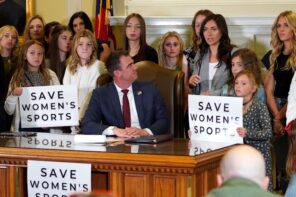When I left Century Campus of Morehouse College a decade ago as a Phi Beta Kappa graduate, I walked away from our commencement exercises approaching six-figures in student loan debt, an insurmountable economic barrier that continues to register new and vacillating levels of regret for the decision to matriculate at my dream school. Suffice it to say, Robert F. Smith—the founder and CEO of Vista Equity Partners who pledged to eliminate the student loan debt of the 2019 class of Morehouse—was not the commencement speaker the year I graduated.
Many American clergy know the torment of being fenced in by educational debt as they painstakingly endeavor to bring dignity and sacred presence to the work of parish life and the constituent lives of communities.
Not unique to any American profession, student loan debt currently economically asphyxiates millions of millennials, cutting off the air supply to emotional well-being, ethical formation, and social innovation. Student loan debt is only surpassed by mortgage debt in the orbit of our consumer-debt economy. America’s student loan crisis exemplifies big banking’s heritage of privatizing profits and socializing losses. One of our national sins, the student loan crisis functions as an engine of inequality that perpetuates socioeconomic stratification, while deceptively packaged as the sole path to social and economic mobility.
While some Catholic clergy and members of religious orders willingly take a vow of poverty, only a small cadre of American clergypersons lives beyond the long reach of financial insecurity in our student loan debt economy. Median clergy salaries starkly contrast with pop-culture caricatures of the minister and the actual phenomenon of the celebrity preacher. The average salary for clergy, serving in churches and other social service settings, is $53,290 per year in the United States, which is on par with the national annual median wage.
Pastor Gabby Cudjoe-Wilkes, who co-pastors The Double Love Experience in Brooklyn with her husband, remarked, “Student debt is one of the most debilitating factors of my financial life.” A recent graduate of Yale Divinity School, she continued, “While I did not take on debt for divinity school, I did take on debt for my first two degrees. At ages 18 and 22, when I signed for my student loans, I anticipated securing employment that would provide adequate opportunities for me to repay them. But, graduating at the same time as America’s economic downturn and choosing to follow my ministerial call in my later twenties provided an inescapable financial crisis.”
At age 22, I furtively carried the emotional weight associated with this financial wound with me into the classrooms and courtyards of the Divinity School of Harvard University, a place of privilege unexpectedly haunted by my looming anxiety around loan default and delayed family planning. Inspired to carry the Morehouse mystique from the pulpit to the public square, I dauntingly whispered to myself a self-affirming expectation that the global community needed my moral vision and sacrifice. In the course of a month, I confronted the emotional turbulence drudged up by unfair conditions mandating that a full-time, multi-degreed professional decide whether to start a family or meet student loan payments; whether to invest his creativity into a congregation or pursue multiple careers in unrelated fields.
Per research conducted by Pastoral Care Inc., 57% of pastors believe they do not receive a livable wage, rendering them unable to pay their bills. 53% of pastors are concerned about their future family’s financial security.
As is the case for more than a fifth of young Americans, many clergy undertake bi-vocational paths of employment just to satisfy monthly loan payments. According to Pew, “About one-in-five employed adults ages 25 to 39 with at least a bachelor’s degree and outstanding student loans (21%) have more than one job.” The Reverend Craig Thomas Robinson, 33, Senior Pastor of Israel AME Church of Albany told RD, “With so much student loan debt looming over me, I find it difficult to fully concentrate on my ministry because I have to find other means to bring in income to pay back my loans.” Due to federal guidelines, clergy employed by houses of worship are ineligible for the Public Service Loan Forgiveness Program, which is available to persons working in the public sector. Curiously, this isn’t on the radar of “religious freedom” activists.
Education debt for clergy jeopardizes the vibrancy of many faith communities and the professional and theological priorities of clergy as parish demographics age into new forms of fixed income and weekly attendance shrinks. On average, seminary students enter theological education with $20,000 or more of debt, nearly doubling from 2007 to 2017 according to the Association of Theological Schools (ATS). In 2018, Master of Divinity graduates exited the ivory towers of seminaries in pursuit of ministry-specific careers with an average of $54,600 of student loan debt. Annually, a burgeoning number of congregations lack the financial ability to support a full-time pastor.
Millions of taxpayers, particularly those fortunate enough to not accrue education debt and those who diligently paid off their debts, reject the idea of taking on the debt of people who consciously entered college with this burden. “If I can pay off my student loans, why can’t they do the same?” When taxpayers breathe oxygen into our most selfish impulses, we obscure the fact that this relief for an entire generation of college graduates, dozens of millions of Americans, energizes the economy more broadly. This problem grows out of corporate greed, not individual mismanagement, and it demands our collective responsibility. Structural and moral crises like this one require a legislative approach that no household savings plan or practice offers.
This macro-investment eviscerates the barriers for student debtors to homeownership, the establishment of significant savings, and new approaches to consumerism. While it shouldn’t take this fact to make it a reality, mass student loan forgiveness ultimately puts more money into our economy.
Many of the 2020 presidential favorites consistently prick the national conscience with bold solutions to this moral crisis. Paid for through a Wall Street Tax, Senator Bernie Sanders (I-Vermont) proposes to cancel $1.6 trillion in outstanding student debt for 45 million borrowers in his student loan forgiveness plan. Senator Elizabeth Warren (D-Massachusetts) submitted a bill to the Senate in late July crafted to forgive $50,000 in student loans for Americans in households earning less than $100,000 annually, resulting in immediate relief to more than an estimated 95% of the 45 million Americans with student debt. The proposed student debt cancellation bill makes eligible any student debtor earning less than $250,000 a year.
Senator Kamala Harris (D-California) unveiled a campaign promise to cancel up to $20,000 of student debt for Pell Grant recipients responsible for initiating and maintaining an entrepreneurial project for three years in underserved communities. Relatedly, the California Senator recently energized the Urban League national convention with an announcement that if she is elected president, there will be a $60 billion-investment in Historically Black Colleges and Universities (HBCUs), institutions where many black clergy matriculate.
These policies signal a turn to monetary mercy for clergy who are silently suffering in our nation, and in many cases living paycheck to paycheck. Student debt cancellation and college affordability work to quell the economic anxieties and unleash new energies in social entrepreneurship that many American congregations add to the economic life of the nation. We need a moral movement that demands the US government realize its responsibility to level and secure the economic floor for all Americans instead of catering to the corporate interests that enliven democratic malpractice in Washington.
The critique of forgiveness plans misunderstands the important differences between the economic realities of the 1980s and 90s and the present. We are graduating debt-laden Americans into a jobs economy currently not structured to provide for the elimination of the person’s student debt. In this post-Great Recession job market and economy, wages remain stagnated, grossly inequitable for nonwhites and women, and housing, college, healthcare, and childcare costs hover at new levels of exorbitance. Even the cost of public higher education has increased 11-fold in the last 40 years.
Previous generations of college graduates knew nothing of the extreme tuition costs and the predatory character of today’s student loans enabled by the effectiveness of a new a generation of student loan lobbyists funding political careers inside the Beltway. In earnest, the current jobs market almost requires graduate and professional degrees beyond the bachelor’s, which expands the weight of student debt in an attempt to compete. However, these highly credentialed and skilled professionals encounter a world where monthly expenses and loan repayment outpace stagnant and declining wages.
The Judeo-Christian traditions possess a heritage of Jubilee—an economic policy in the life of the ancient Hebrew nation that canceled debts at the end of seven cycles of shmita (Sabbatical years). This heritage centers monetary mercy as an act of human fulfillment, social sustainability, and moral obligation. A Congress with so many members loudly proclaiming their religious bona fides only needs the will to legislate a student debt jubilee that blows oxygen into the economic possibilities of younger Americans. Amen.





